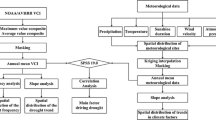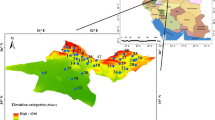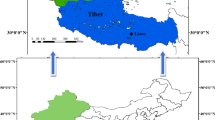Abstract
Remote sensing freely provides many processed image products such as moderate resolution imaging spectroradiometer (MODIS), and long-term data record (LTDR), for the investigation of drought evolution. Our objectives are to investigate drought evolution and spatiotemporal variations from 1982 to 2017 based on two remote-sensing indices, namely, the normalized difference vegetation index (NDVI) and the vegetation condition index (VCI), and a popular meteorological index—standardized precipitation index (SPI)—under four different land cover types, cropland, forestland, grassland, and desertland in China. The modified Mann–Kendall test was used to detect the significance of a trend. The Pearson correlation method was used to find the relationship between NDVI anomaly, VCI, precipitation, and SPI. The results revealed that (a) both mean monthly and yearly precipitation had a general land cover type rank of forestland > grassland ≈ cropland > desertland. (b) A positive correlation was found between drought indices (NDVI anomaly, VCI, SPI) and precipitation for different land cover types. The NDVI anomaly and VCI were well correlated with 3-month SPI for cropland and were well correlated with 6-month SPI for forestland. VCI performed better than NDVI anomaly when correlating with SPI. (c) The coefficient of determination (R2) was obtained for precipitation and VCI in the driest (2011) and wettest (2016) years. The R2 values for desert and grassland ranged from 0.70 to 0.90 and for cropland and forestland were lower (0.54–0.69). (d) Only precipitation, SPI, and VCI of cropland had significant increasing trends. The spatial distribution patterns of precipitation, NDVI, and VCI increased with the decreased elevation. The study revealed that desert and grassland had been regularly exposed to moderate or extreme droughts conditions and confirmed that desert and grassland are more sensitive to short-term drought.











Similar content being viewed by others
Abbreviations
- MODIS:
-
Moderate resolution imaging spectroradiometer
- NDVI:
-
Normalized difference vegetation index
- VCI:
-
Vegetation condition index
- SPI:
-
Standardized precipitation index
- VHI:
-
Vegetation health index
- SPEI:
-
Standardized precipitation evapotranspiration index
- PDSI:
-
Palmer Drought Severity Index
- RS:
-
Remote sensing
References
Adnan S, Ullah K, Shuanglin L, Gao S, Khan AH, Mahmood R (2018) Comparison of various drought indices to monitor drought status in Pakistan. Clim Dyn 51:1885–1899
Ayantobo OO, Li Y, Song S, Yao N (2017) Spatial comparability of drought characteristics and related return periods in mainland China over 1961–2013. J Hydrol 550:549–567
Aziz A et al (2018) Assessment of drought conditions using HJ-1A/1B data: a case study of Potohar region, Pakistan Geomatics. Natural Hazards and Risk 9:1019–1036
Bontemps S, Defourny P, Bogaert EV, Arino O, Kalogirou V, Perez JR (2011) GLOBCOVER 2009 - Products description and validation report. UCLouvain & ESA Team, Louvain
Carlson TN, Ripley DA (1997) On the relation between NDVI, fractional vegetation cover, and leaf area index. Remote Sens Environ 62:241–252
Cheng M, Jin J, Zhang J, Jiang H, Wang R (2018) Effect of climate change on vegetation phenology of different land-cover types on the Tibetan Plateau. Int J Remote Sens 39:470–487
Cong D, Zhao S, Chen C, Duan Z (2017) Characterization of droughts during 2001–2014 based on remote sensing: a case study of Northeast China. Ecological Informatics 39:56–67
Dodamani B, Anoop R, Mahajan D (2015) Agricultural drought modeling using remote sensing. Int J Environ Sci Dev 6:326–331
Dutta D, Kundu A, Patel NR, Saha SK, Siddiqui AR (2015) Assessment of agricultural drought in Rajasthan (India) using remote sensing derived Vegetation Condition Index (VCI) and Standardized Precipitation Index (SPI). Egypt J Remote Sens Space Sci 18:53–63
El-Vilaly MAS, Didan K, Marsh SE, van Leeuwen WJ, Crimmins MA, Munoz AB (2018) Vegetation productivity responses to drought on tribal lands in the four corners region of the Southwest USA. Front Earth Sci 12:37–51
Ezzine H, Bouziane A, Ouazar D (2014) Seasonal comparisons of meteorological and agricultural drought indices in Morocco using open short time-series data. Int J Appl Earth Obs Geoinf 26:36–48
Gidey E, Dikinya O, Sebego R, Segosebe E, Zenebe A (2018) Using drought indices to model the statistical relationships between meteorological and agricultural drought in Raya and its environs, Northern Ethiopia Earth Systems and Environment:1-15
Hayes MJ, Svoboda MD, Wiihite DA, Vanyarkho OV (1999) Monitoring the 1996 drought using the standardized precipitation index. Bull Am Meteorol Soc 80:429–438
Hoscilo A et al (2015) A conceptual model for assessing rainfall and vegetation trends in sub-Saharan Africa from satellite data. Int J Climatol 35:3582–3592
Hu Q, Torres-Alavez JA, Van Den Broeke MS (2018) Land-cover change and the “dust bowl” drought in the US Great Plains. J Clim 31:4657–4667
Jiao W, Zhang L, Chang Q, Fu D, Cen Y, Tong Q (2016) Evaluating an enhanced vegetation condition index (VCI) based on VIUPD for drought monitoring in the continental United States. Remote Sens 8:224
Kendall M (1976) Rank Auto Correlation Methods. Griffin, Oxford
Lamchin M, Park T, Lee JY, Lee WK (2015) Monitoring of vegetation dynamics in the Mongolia using MODIS NDVIs and their relationship to rainfall by natural zone. J Indian Soc Remote Sensing 43:325–337
Li J, Huang D, Li F, Wen Z (2018) Circulation characteristics of EP and CP ENSO and their impacts on precipitation in South China. J Atmos Sol Terr Phys 179:405–415
Li Y, Chen C, Sun C (2017) Drought severity and change in Xinjiang, China, over 1961–2013. Hydrol Res 48:1343–1362
Liang L, Qin S, Xiang L, Wang J, Liu Z (2017) Long-term spatial and temporal variations of vegetative drought based on vegetation condition index in China Ecosphere 8:e01919
Lightfoot DC, Davidson AD, Parker DG, Hernández L, Laundré JW (2012) Bottom-up regulation of desert grassland and shrubland rodent communities: implications of species-specific reproductive potentials Journal of Mammalogy 93:1017-1028
Lkhagvadorj N, Jiahua Z, Battsetseg T, Mohsen N, Sha Z, Yun Baia. (2019) NDVI anomaly for drought monitoring and its correlation with climate factors over Mongolia from 2000 to 2016 Journal of Arid Environments 164:69–77
Lloyd H, Benjamin S, Mark A (2002) A drought climatology for Europe International journal of climatology 22:1571-1592
Mann HB (1945) Nonparametric tests against trend Econometrica: Journal of the Econometric Society:245-259
McKee TB, Doesken NJ, Kleist J (1993) The relationship of drought frequency and duration to time scales. In: Proceedings of the 8th Conference on Applied Climatology. vol 22. American Meteorological Society Boston, MA, pp 179-183
Mishra AK, Singh VP (2011) Drought modeling – a review Journal of Hydrology 403:157-175
National Bureau of Statistics (2017) China statistical yearbook 2011. Beijing: China Statistics Press Retrieved 29 May 2017
Pathak AA, Dodamani B (2018) Assessment of agricultural drought by remote sensing technique. In: Remote sensing for agriculture, ecosystems, and hydrology XX. International Society for Optics and Photonics, p 1078316
Pei F et al (2018) Monitoring the vegetation activity in China using vegetation health indices. Agric For Meteorol 248:215–227
Peng J, Dong W, Yuan W, Zhang Y (2012) Responses of grassland and forest to temperature and precipitation changes in Northeast China Advances in Atmospheric sciences 29:1063-1077
Pramudya Y, Onishi T Assessment of the Standardized Precipitation Index (SPI) in Tegal City, Central Java, Indonesia. In: IOP Conference Series: Earth and Environmental Science, 2018. vol 1. IOP Publishing, p 012019
Quiring SM, Ganesh S (2010) Evaluating the utility of the Vegetation Condition Index (VCI) for monitoring meteorological drought in Texas Agricultural and Forest Meteorology 150:330-339
Rimkus E, Stonevicius E, Kilpys J, Maciulyte V, Valiukas D (2017) Drought identification in the eastern Baltic region using NDVI Earth System Dynamics 8
Rui LI, Tsunekawa A, Tsubo M (2014) Index-based assessment of agricultural drought in a semi-arid region of Inner Mongolia. China Science in Arid Zones 6:3–15
Schmidt M, Klein D, Conrad C, Dech S, Paeth H (2014) On the relationship between vegetation and climate in tropical and northern Africa Theoretical & Applied Climatology 115:341-353
Sen PK (1968) Estimates of the regression coefficient based on Kendall’s tau Journal of the American statistical association 63:1379-1389
Shaojie MU, Yang H, Jianlong LI, Chen Y, Gang C, Zhou W, Weimin JU (2013) Spatio-temporal dynamics of vegetation coverage and its relationship with climate factors in Inner Mongolia. China J Geogr Sci 23:231–246
Swets DL A weighted least-squares approach to temporal smoothing of NDVI. In: 1999 ASPRS annual conference, from image to information. Portland, Proceedings. American society for photogrammetry and remote sensing, Bethesda, 17-21 May 1999, 1999.
Tirivarombo S, Osupile D, Eliasson P (2018) Drought monitoring and analysis: Standardised Precipitation Evapotranspiration Index (SPEI) and Standardised Precipitation Index (SPI) Physics and Chemistry of the Earth. Parts A/B/C 106:1–10
Unganai LS, Kogan FN (1998) Drought monitoring and corn yield estimation in Southern Africa from AVHRR data Remote sensing of environment 63:219-232
Wang J, Sun Z, Hui D, Yang L, Wang F, Liu N, Ren H (2018a) Responses of seedling performance to altered seasonal precipitation in a secondary tropical forest, southern China Forest Ecology and Management 410:27-34
Wang S, Mo X, Hu S, Liu S, Liu Z (2018b) Assessment of droughts and wheat yield loss on the North China Plain with an aggregate drought index (ADI) approach Ecological Indicators 87:107-116
Winkler K, Gessner U, Hochschild V (2017) Identifying droughts affecting agriculture in Africa based on remote sensing time series between 2000–2016: rainfall anomalies and vegetation condition in the context of ENSO Remote Sensing 9:831
Wu Y et al. (2018) The characteristics of regional heavy precipitation events over eastern monsoon China during 1960–2013 Global and Planetary Change
Yan H et al. (2016) Assessing spatiotemporal variation of drought in China and its impact on agriculture during 1982–2011 by using PDSI indices and agriculture drought survey data Journal of Geophysical Research: Atmospheres 121:2283-2298
Yao N, Li Y, Lei T, Peng L (2018) Drought evolution, severity and trends in mainland China over 1961–2013. Sci Total Environ 616:73–89
Yue S, Wang CY (2002) Regional streamflow trend detection with consideration of both temporal and spatial correlation International Journal of Climatology 22:933-946 doi:https://doi.org/10.1002/joc.781
Zambrano F, Lillo-Saavedra M, Verbist K, Lagos O (2016) Sixteen years of agricultural drought assessment of the biobío region in Chile using a 250 m resolution vegetation condition index (VCI) Remote Sensing 8:530
Zhai J, Su B, Krysanova V, Vetter T, Gao C, Jiang T (2010) Spatial variation and trends in PDSI and SPI indices and their relation to streamflow in 10 large regions of China. J Clim 23:649–663
Zhai P, Zhang X, Wan H, Pan X (2005) Trends in total precipitation and frequency of daily precipitation extremes over China Journal of Climate 18:1096-1108 doi:https://doi.org/10.1175/jcli-3318.1
Zhang J, Shen Y (2019) Spatio-temporal variations in extreme drought in China during 1961–2015. J Geogr Sci 29:67–83
Zhang L, Jiao W, Zhang H, Huang C, Tong Q (2017) Studying drought phenomena in the Continental United States in 2011 and 2012 using various drought indices Remote sensing of environment 190:96-106
Zhao N, Yue T, Li H, Zhang L, Yin X, Liu Y (2018) Spatio-temporal changes in precipitation over Beijing-Tianjin-Hebei region. China Atmos Res 202:156–168
Funding
The authors acknowledge the financial support of the National Key Research and Development Program of China (Grant No. 2017YFC0403303), the Foreign Expert Introduction Project (G20190027163), and the China 111 project (B12007).
Author information
Authors and Affiliations
Corresponding author
Ethics declarations
Conflict of interest
The authors declare that they have no conflict of interest.
Additional information
Responsible editor: Philippe Garrigues
Publisher’s note
Springer Nature remains neutral with regard to jurisdictional claims in published maps and institutional affiliations.
Electronic supplementary material
ESM 1
(DOCX 897 kb)
Rights and permissions
About this article
Cite this article
Javed, T., Yao, N., Chen, X. et al. Drought evolution indicated by meteorological and remote-sensing drought indices under different land cover types in China. Environ Sci Pollut Res 27, 4258–4274 (2020). https://doi.org/10.1007/s11356-019-06629-2
Received:
Accepted:
Published:
Issue Date:
DOI: https://doi.org/10.1007/s11356-019-06629-2




